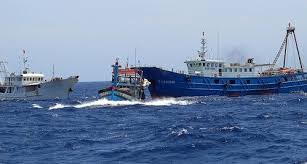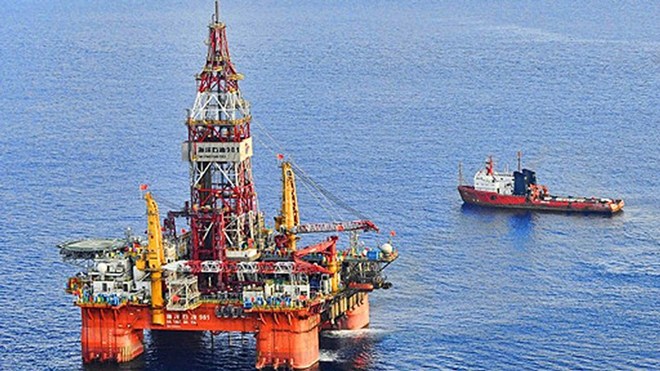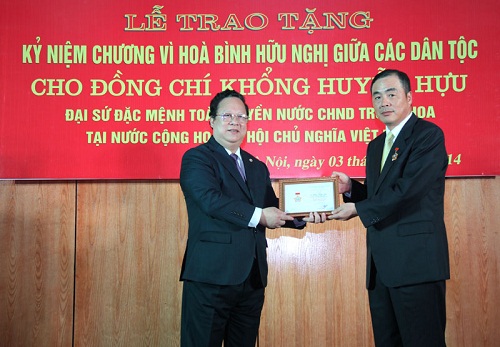Chinese ships protect the oi rig (Photo: VNA)
Meanwhile, Vietnam’s fishing boats kept their normal catching activities about 35-40 nautical miles from the rig, demanding their fishing grounds .
In addition to protesting China’s violation of Vietnam’s sovereignty, the fisheries surveillance ships always stood side by side with fishing boats to support and protect them from Chinese vessels.
On the day, China maintained nearly 120 ships, including 40 coast guard vessels, over 30 cargo ships and tugboats, 35-40 fishing boats and four warships. A Y-8 aircraft was spotted to fly above the rig at a height of 300-500m.
China’s fishing boats, backed by two coast guard ships, continued to hinder Vietnamese fisheries surveillance and fishing ships from accessing the rig.
They acted more spontaneous, pushing Vietnam’s fishing boats away from the rig about 35-40 nautical miles.
The Chinese vessels organised in group, about 7-8 or 9-11 nautical miles from the rig, to aggressively prevent and stand ready to ram against and fire water cannons at the Vietnamese ships.
The Vietnamese fisheries surveillance and fishing ships remained safe despite the Chinese aggression.
At the beginning of May 2014, China illegally dispatched the rig as well as a large fleet of armed vessels, military ships and aircraft to Vietnam’s waters and positioned the rig at 15 degrees 29 minutes 58 seconds north latitude and 111 degrees 12 minutes 06 seconds east longitude. The location is 80 miles deep inside Vietnam ’s continental shelf and exclusive economic zone.
On May 27, China expanded the rig’s operation by moving it to 15 degrees 33 minutes 22 seconds north latitude and 111 degrees 34 minutes 36 seconds east longitude, 25 nautical miles from Tri Ton Island in Vietnam ’s Hoang Sa archipelago and 23 nautical miles east-northeast from the old location.
On June 3, the oil rig moved yet again to another new position, at 15 degrees 33 minutes 36 seconds north latitude and 111 degrees 34 minutes 11 seconds east longitude. The new position is still completely within Vietnam ’s continental shelf.-VNA
In addition to protesting China’s violation of Vietnam’s sovereignty, the fisheries surveillance ships always stood side by side with fishing boats to support and protect them from Chinese vessels.
On the day, China maintained nearly 120 ships, including 40 coast guard vessels, over 30 cargo ships and tugboats, 35-40 fishing boats and four warships. A Y-8 aircraft was spotted to fly above the rig at a height of 300-500m.
China’s fishing boats, backed by two coast guard ships, continued to hinder Vietnamese fisheries surveillance and fishing ships from accessing the rig.
They acted more spontaneous, pushing Vietnam’s fishing boats away from the rig about 35-40 nautical miles.
The Chinese vessels organised in group, about 7-8 or 9-11 nautical miles from the rig, to aggressively prevent and stand ready to ram against and fire water cannons at the Vietnamese ships.
The Vietnamese fisheries surveillance and fishing ships remained safe despite the Chinese aggression.
At the beginning of May 2014, China illegally dispatched the rig as well as a large fleet of armed vessels, military ships and aircraft to Vietnam’s waters and positioned the rig at 15 degrees 29 minutes 58 seconds north latitude and 111 degrees 12 minutes 06 seconds east longitude. The location is 80 miles deep inside Vietnam ’s continental shelf and exclusive economic zone.
On May 27, China expanded the rig’s operation by moving it to 15 degrees 33 minutes 22 seconds north latitude and 111 degrees 34 minutes 36 seconds east longitude, 25 nautical miles from Tri Ton Island in Vietnam ’s Hoang Sa archipelago and 23 nautical miles east-northeast from the old location.
On June 3, the oil rig moved yet again to another new position, at 15 degrees 33 minutes 36 seconds north latitude and 111 degrees 34 minutes 11 seconds east longitude. The new position is still completely within Vietnam ’s continental shelf.-VNA













